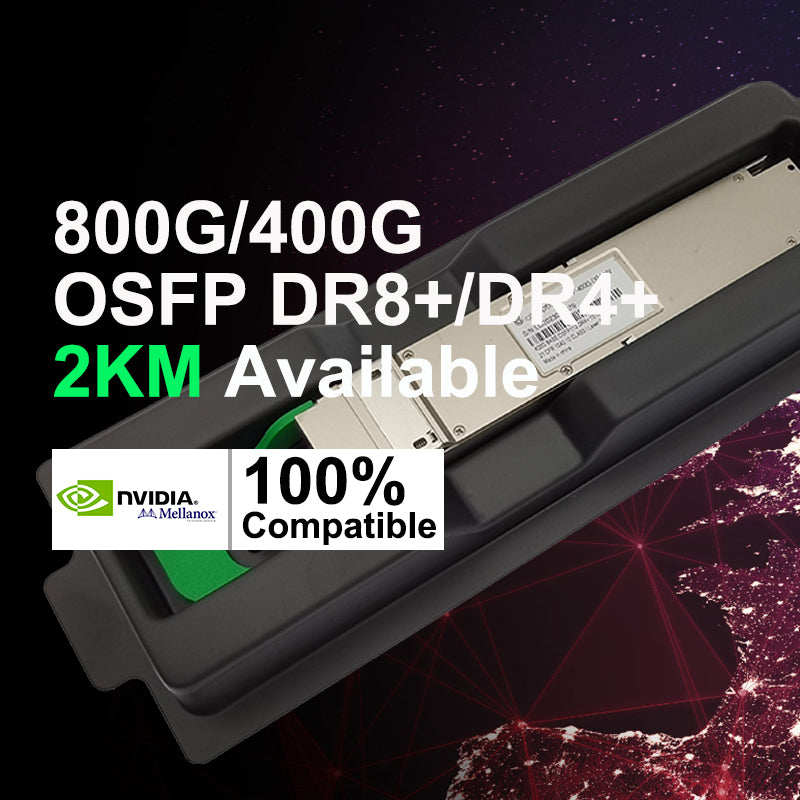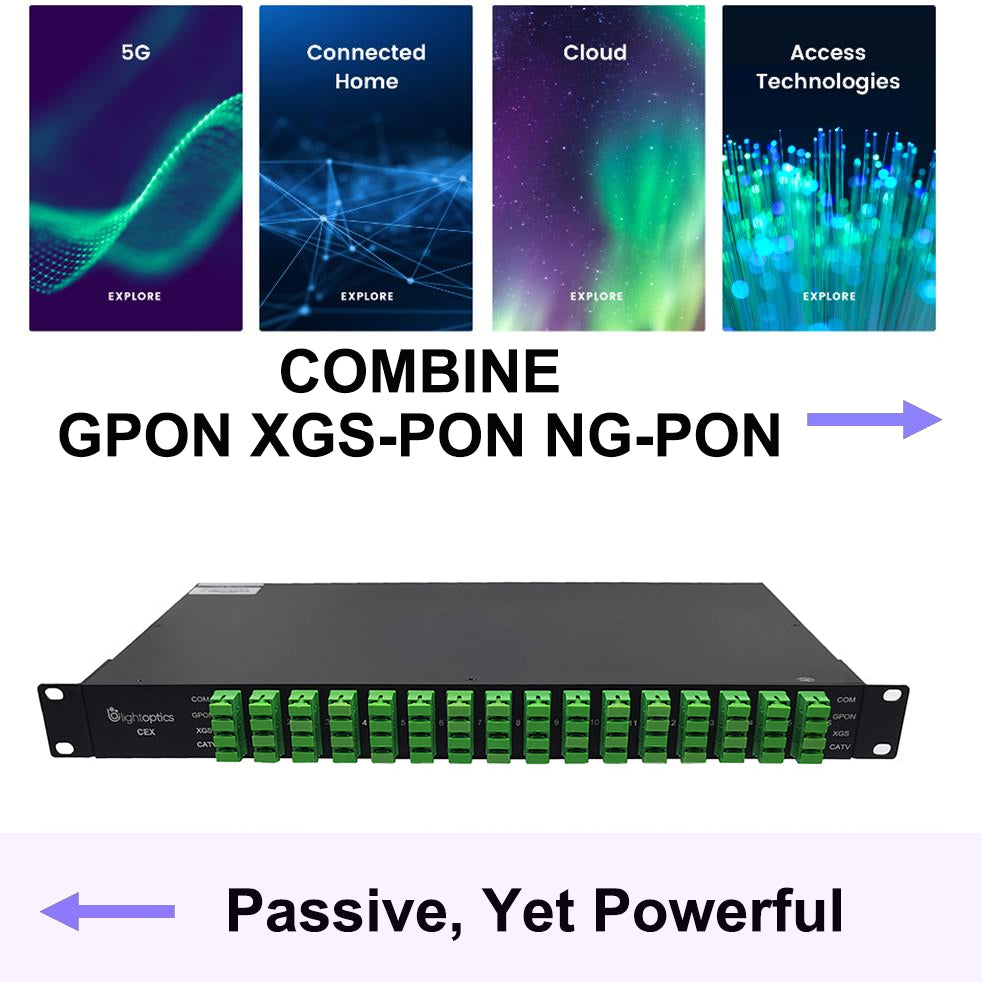CWDM vs DWDM – What is the difference?
Coarse Wavelength Division Multiplexers (CWDM) :
CWDM stands for Coarse wavelength division multiplexers. A CWDM system commonly supports eight wavelengths per fiber and is designed for short-range communications, using wide-range frequencies with wavelengths spread far apart. These are modules that increases the amount of bandwidth the fiber optic system will carry by transmitting multiple signals at various wavelengths along the fiber optic cables.
Since CWDM is based on 20-nm channel spacing from 1470 to 1610 nm, it's typically deployed on fiber spans up to 80km or less because optical amplifiers cannot be used with large spacing channels. This wide spacing of channels allows the use of moderately priced optics. However, the capacity of the links as well as the distance supported are less with CWDM than with DWDM.
Generally, CWDM is used for lower cost, wider range frequencies, lower capacity (sub-10G) and shorter distance applications where cost is an important factor.
Dense Wavelength Division Multiplexers (DWDM) :
DWDM stands for Dense wavelength division multiplexers.
These are modules that put data from different sources together on a fiber optic cable. There modules further increase system bandwidth and capacity by using closely spaced wavelengths to carry multiple signals on the same cable.
In DWDM systems, the number of multiplexed channels is much denser as compared to CWDM because DWDM uses tighter wavelength spacing to fit more channels onto a single fiber. In addition to the capability of supporting a greater number of wavelengths than CWDM, DWDM platforms are also capable of handling higher speed protocols as most optical transport equipment vendors today commonly support 100G or 200G per wavelength while emerging technologies are allowing for 400G and beyond.
CWDM vs DWDM, What Are Their Differences?
CWDM and DWDM are both effective methods to solve the increasing bandwidth capacity of information transmission at present. But they differ from each other in many aspects. Below parts will introduce some differences between CWDM and DWDM systems.
CWDM vs DWDM: Channel Spacing
The channel spacing is defined to be the nominal difference in frequency or wavelength between two adjacent optical channels.
CWDM has a wider spacing than DWDM. It is able to transport up to 18 CWDM wavelengths with a channel spacing of 20nm in the spectrum grid from 1271nm to 1611nm. DWDM can carry 40, 80, or up to 160 wavelengths with a narrower spacing of 0.8/0.4nm (100 GHz/50 GHz grid). Its wavelengths are from 1525nm to 1565nm (C band) and 1570nm to 1610nm (L band). In DWDM systems, the number of multiplexed channels is much denser than CWDM because DWDM uses tighter wavelength spacing to fit more channels onto a single fiber.
Instead of the 20 nm channel spacing used in CWDM (equivalent to approximately 15 million GHz), DWDM systems utilize a variety of specified channels spacing from 12.5 GHz to 200 GHz in the C-Band and sometimes the L-band. Today's DWDM systems typically support 96 channels spaced at 0.8 nm apart within the 1550 nm C-Band spectrum. Because of this, DWDM systems can transmit a huge quantity of data through a single fiber link as they allow for many more wavelengths to be packed onto the same fiber.

To recap, both CWDM and DWDM use differing wavelengths of light to transmit data over a single fiber, however they differ in the spacing of the wavelengths and the number of channels that they can each carry. Wavelengths on DWDM are packed more densely (hence the name) than on CWDM, and the signals can be amplified, enabling data to be transmitted over longer distances.
CWDM vs DWDM: Transmission Distance
Because the DWDM wavelength is highly integrated with optical fiber in the process of optical transmission, DWDM's transmission distance is farther than CWDM. Unlike the DWDM system, CWDM cannot transmit optical signals with unlimited distance. The maximum transmission distance of CWDM is about 80 km. DWDM can make the transmission distance farther according to the dispersion compensation or amplifier.
CWDM vs DWDM: Modulation Laser
As lasers reach higher temperatures, they transmit light at a slightly different frequency and can therefore “drift” off a narrow frequency window. Because DWDM systems have closely spaced wavelengths, they need to maintain a more stable frequency than for CWDM with its wider channel spacing. To solve this problem with DWDM, cooled lasers are used to ensure accuracy for a longer period of time. The drawback to this is higher power usage and more complexity which can result in higher costs in running DWDM. Historically, DWDM transceivers have been more expensive, with the majority of the manufacturing costs coming from the laser. However, the technology has now developed to a point where prices between CWDM and DWDM are much closer.
CWDM vs DWDM: Cost
Because the range of temperature distribution is nonuniform in a very wide wavelength, so the temperature tuning is very difficult to realize, thus using the cooling laser technique increases the cost of the DWDM system. Furthermore, the DWDM devices are typically four or five times more expensive than that of a CWDM system. However, the price of a DWDM transceiver is about 20-25% less than a CWDM transceiver on account of the popularization of DWDM.
CWDM vs DWDM: Advantages and Disadvantages
As mentioned above, the primary difference between DWDM and CWDM is the channel spacing (CWDM has almost 100 times wider channel spacing). This makes CWDM a simpler technology, resulting in advantages and disadvantages of the different systems with regard to cost, performance, and so on.
CWDM Advantages and Disadvantages
| CWDM Advantages | CWDM Disadvantages |
| Lower power consumption | Less capacity than DWDM |
| Smaller space requirements | Less range |
| Can use SMF fiber or MMF cable | Regeneration vs amplification |
| Can use LED’s or Laser’s for power | O, A and M functions are not carrier-class |
| Larger individual payloads per channel | |
| Smaller and cheaper wave filters | |
| Cost savings on start-up and expansion |
DWDM Advantages and Disadvantages
| DWDM Advantages | DWDM Disadvantages |
| Maximum capacity system available | Need more space |
| Maximum distance capability with EDFA’s | Need more power |
| Repeater “amp” sites can be reduced | Need high accuracy lasers and wave filters |
| Pay as you grow expansion | Expensive EDFA’s for amplifiers |
| Mature O, A and M systems are developed | Start-up costs are more than the equivalent CWDM system |
Conclusion
It is difficult to compare DWDM and CWDM against one another. The true difference is the number of channels needed by the customer and the cost associated with deploying each system. If you still don’t make your mind, please feel free to contact us. LightOptics, a professional and successful telecommunication supplier, offers a variety of CWDM and DWDM equipment and we are welcomed to be at your service.












